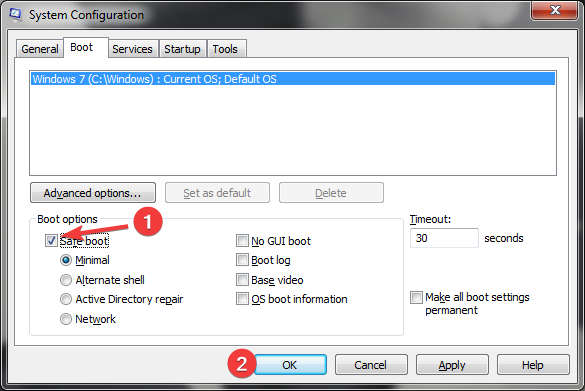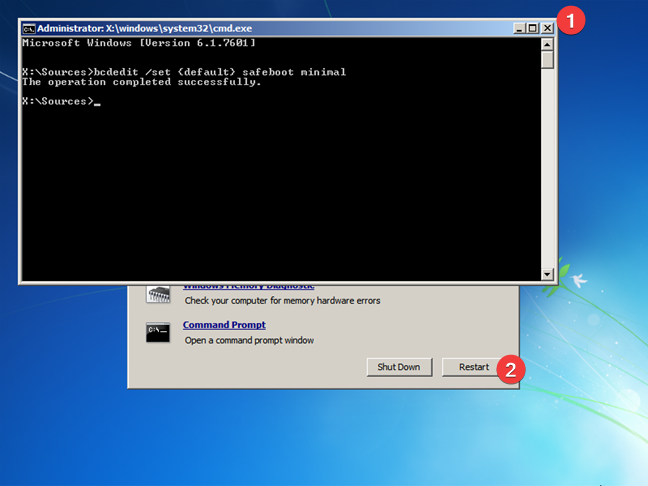
- #HOW TO ENTER SAFE MODE ON WINDOWS 7 PRO#
- #HOW TO ENTER SAFE MODE ON WINDOWS 7 PC#
- #HOW TO ENTER SAFE MODE ON WINDOWS 7 WINDOWS 8#
- #HOW TO ENTER SAFE MODE ON WINDOWS 7 WINDOWS 7#
Regardless what you choose, the next time you will restart your computer, you will be rebooting in the Safe Mode. When you will click on OK another dialogue box will appear asking if you wish to Restart right now or Exit Without Restart. Also, click on the radio button labelled as Minimal. Select the 'Boot' tab and under ' Boot Options' click on the check mark next to ' Safe Boot'. This will open the System Configuration Window. You can also just press the Windows Key and in the Start Menu you can type MSCONFIG in the search box. Type MSCONFIG (case doesn't matter) and click on 'OK'.

Press the Windows Key and 'R' together to open the Run dialogue box.
#HOW TO ENTER SAFE MODE ON WINDOWS 7 PC#
It is pretty easy to reboot your PC using this method into Safe Mode. Part 1: Using MSCONFIG to Forcibly Reboot the PC into Safe Mode
#HOW TO ENTER SAFE MODE ON WINDOWS 7 PRO#
If you're locked out of Windows 10, iSeePassword Windows Password Recovery Pro will be your best choice to unlock your computer. So, here are the ways to boot Windows from Safe Mode as and when you need it. In any case, this is involuntary and is certainly not the way you wish to be given the option to enter the Safe Mode. This could happen when the power supply to the computer is abruptly interrupted or there is a malfunctioning program that disrupted the normal functioning of the OS. When the Windows PC does not shut down correctly, upon restarting, the system will automatically ask you if you would like to enter the Safe Mode first.
#HOW TO ENTER SAFE MODE ON WINDOWS 7 WINDOWS 8#
For newer versions, Windows 8 and above, the steps vary.
#HOW TO ENTER SAFE MODE ON WINDOWS 7 WINDOWS 7#
In fact, for Windows 7 and older versions the method is more or less the same. There are many ways to go into Safe Mode, depending upon the version of Windows you are using. While in the safe mode, there is lesser risk of destabilizing your computer and thus it gets its name. The Safe Mode is usually required when you need to disable certain programs in order to troubleshoot them or to replace/repair some system files. You will enter winRE.Safe Mode is one of the boot options for Windows OS wherein it runs with the minimum required functions and features. If you need more info on a black or blank screen error, see Troubleshoot black or blank screen errors.Īllow your device to fully restart. Select option 5 from the list or press F5 for Safe Mode with Networking. On the Choose an option screen, select Troubleshoot > Advanced options > Startup Settings > Restart.Īfter your device restarts, you'll see a list of options. Now that you are in winRE, you will follow these steps to take you to safe mode: When Windows restarts, hold down the power button for 10 seconds to turn off your device.Īllow your device to restart into Automatic Repair, and select Advanced options to enter winRE.

On the first sign that Windows has started (for example, some devices show the manufacturer’s logo when restarting) hold down the power button for 10 seconds to turn off your device. Press the power button again to turn on your device. Hold down the power button for 10 seconds to turn off your device. To do this, you will repeatedly turn your device off, then on: Note: If you’ve encrypted your device, you’ll need your BitLocker key to start in safe mode.īefore you enter safe mode, you need to enter the Windows Recovery Environment (winRE).


 0 kommentar(er)
0 kommentar(er)
